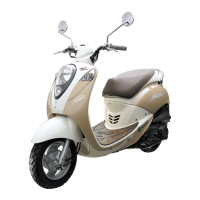17. Emission Control System
17-1
Names of Mechanisms in the Emission
Control System···································· 17-1
Function of Mechanisms in the Emission
Control System···································· 17-1
Fuel Evaporative Emission Control System
(E.E.C.) ················································· 17-2
Evaporative Emission Control System
(EEC) ···················································· 17-3
Catalytic Converting System (CATA) · 17-4
Positive Crankcase Ventilation System
(P.C.V.)·················································· 17-5
Inspection Items··································· 17-6
Countermeasure for Emission Pollutants
Not Within Standard as In Idle Speed
(4-Stroke Engine) ································· 17-7
Names of Mechanisms in the Emission Control System
Four-Stroke Engine Model
1. Catalyst converter (CATA)
2. Evaporative Emission Control System (EEC)
3. Positive Crankcase Ventilation System (PCV)
Function of Mechanisms in the Emission Control System
General
The emission control strategy of this model was formulated basing on a four-stroke SOHC carburetor
single cylinder engine. It adopts secondary air introducing device to purify the exhaust, in addition, it also
adopts a charcoal canister to absorb the fuel vapor generated through evaporation in the fuel system.
※ Engine refinements -
Four Valves designed combustion chamber, together with optimum compression ratio, ignition timing,
intake and exhaust timing, have all contributed to maximize the intake/exhaust efficiency and
combustion efficiency.
※ Secondary air introducing system -
It is used to introduce secondary air into exhaust manifold so that incomplete burned exhausts, CO &
HC, may be burned again and to be harmless gases.
System Device Components Purpose & function
Combustion
chamber
Combustion
chamber
4-valve combustion
chamber
The semi-circular combustion chamber is
designed to balancing the air stream to achieve
the combustion stability.
Exhaust
system
Post-treatment
device
Catalytic converter
Installed a three-way catalytic converter in the
middle of exhaust pipe to oxidize the CO, HC in
the exhaust gas.
EEC system
Evaporative
emission control
system
Charcoal canister
Purge control valve
canister is used to absorb vapor from fuel tank
and to introduce it into carburetor at an
opportune timing.
PCV system
Crankcase blow-by
introducing device
Vapor separator
To introduce blow-by into combustion chamber
via a vapor separator for burning then
discharging.
17
Home page
Contents

